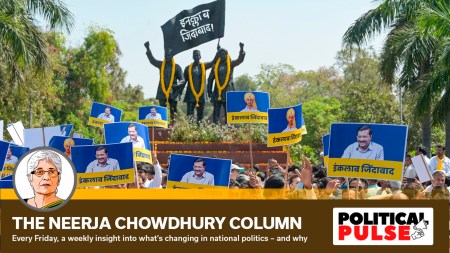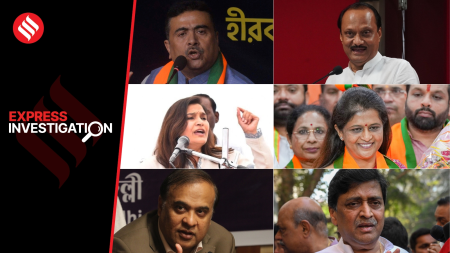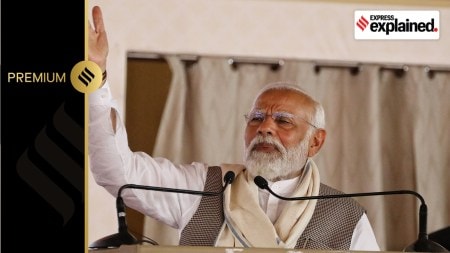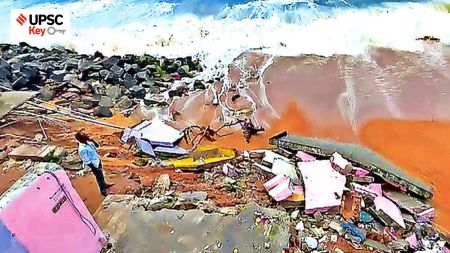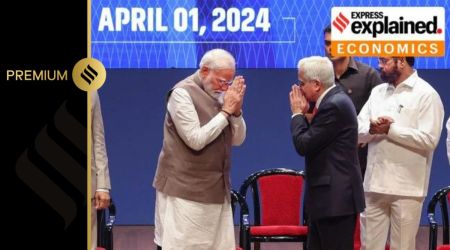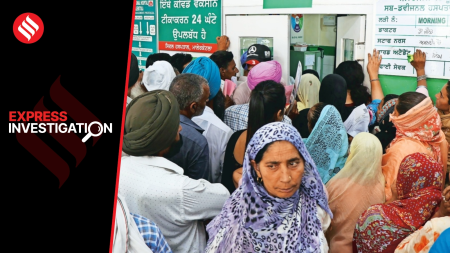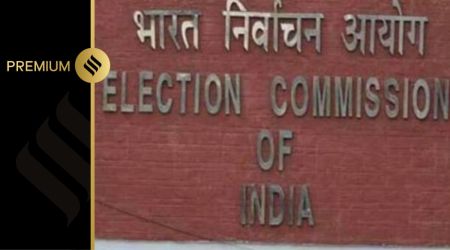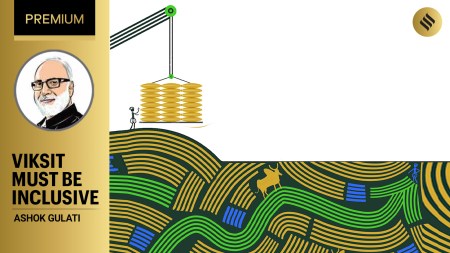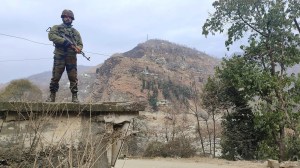- India
- International
Strategy and foreign affairs for India in 2024: dealing with realities, looking at opportunities
The outcome of the Lok Sabha elections will send strategic signals to the neighbourhood and the world about the direction in which India is headed in 2024 and beyond. Next year could be one of the most consequential ever for Indian foreign policy and strategy.
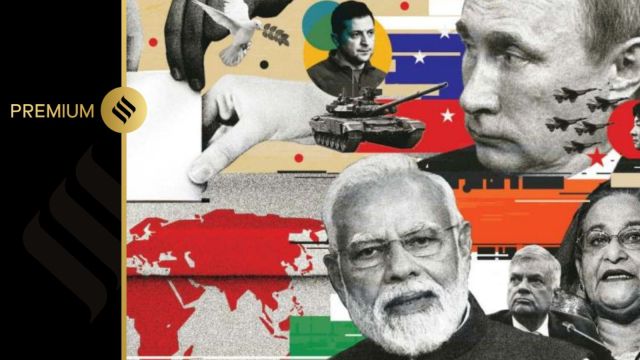 Looking ahead, other conflicts around the world present clear challenges. Around 40 countries will see national elections next year. (Express illustration by Suvajit Dey)
Looking ahead, other conflicts around the world present clear challenges. Around 40 countries will see national elections next year. (Express illustration by Suvajit Dey)In 2022, Prime Minister Narendra Modi told President Vladimir Putin that “this is not the era of war”. Yet, 2023 became a year of wars: fighting between Russia and Ukraine could soon enter its third year, and the ongoing war in the Gaza Strip, triggered by Hamas’ October 7 attack, is now among the most destructive conflicts of recent decades.
Looking ahead, other conflicts around the world present clear challenges. China’s belligerence has not abated even as its economy has shown some signs of difficulty — and that worries the West and India.
2023: Strategic realities
1. CRISIS IN THE MIDDLE EAST: Two years of sustained effort to normalise ties between Israel and the Arab world was disrupted by the Hamas attack in which more than 1,200 civilians and military personnel were killed, and more than 230 taken hostage.
Israel’s angry and disproportionate response has so far killed more than 20,000 Palestinians in Gaza — which has attracted criticism from even the US. The Israeli-Arab reconciliation process has been derailed for now, and the future of Gaza is unknown.
2. STRESS IN INDIA-US TIES: After successful visits by PM Modi and President Joe Biden to each other’s capitals, bilateral ties are facing headwinds over allegations of an Indian official link to an assassination plot against a Khalistani separatist in the US.

India’s response has been different from the way it reacted to Canada when it suggested an Indian government link to the murder of another Khalistani in that country. The PM has expressed India’s “commitment to the rule of law”, and promised to “look into” the role of Indian citizens in the alleged US plot if information is provided.
3. RUSSIA-UKRAINE WAR FATIGUE: As the war drags on, the West is facing funding challenges. Ukraine hopes to get €18.5 billion from the European Union and more than $8 billion from a US package that also contains vital military assistance. But the assistance has been blocked — by Republicans in the US Congress and by Hungary in the EU — so far.
Meanwhile, Putin’s re-election as Russia’s President is a foregone conclusion. The Russian economy has been resilient despite sanctions, and proximity between Moscow and Beijing worries the West.
4. INDIA’S MALDIVES CHALLENGE: The government of President Mohamed Muizzu, who rode an “India Out” campaign to power, has asked India to withdraw military personnel stationed in the Maldives, and conveyed its intention to terminate a water survey pact. The Muizzu establishment is considered close to China.
5. CHINA, THE BIGGEST WORRY: China continues to be India’s biggest worry and strategic challenge. The border standoff is in its fourth winter, with the force posture being maintained to rival the Chinese military presence. The dependence of Moscow, India’s strategic defence partner, on Beijing for economic survival, and the Maldives getting closer to China in the Indian Ocean have added to the concern.
6. G20, GLOBAL SOUTH POSITIONING: India’s success in negotiating a joint declaration at the G20 summit came as a surprise for many in the international community. A big takeaway from the G20 process was New Delhi’s mobilisation of developing and less developed countries under the umbrella of the Global South. The idea of leading the Global South is seen as taking forward the legacy of India’s Non-Alignment leadership, only adapted to the 21st century.
7. TOWARDS ENGAGEMENT IN KABUL: There has been a change of guard in the Afghanistan embassy in New Delhi, with the incumbent ambassador leaving and that country’s diplomats in Mumbai and Hyderabad stepping in to take charge. To India’s relief, they have assured they won’t fly the Taliban flag or have Taliban nomenclature in their official correspondence.
However, India is engaging with the Taliban — a technical team has been posted at the embassy in Kabul, and the present team in the Afghan embassy in New Delhi is coordinating with the regime for providing passport and visa services for Afghan nationals. China has posted a full-time envoy in Kabul.
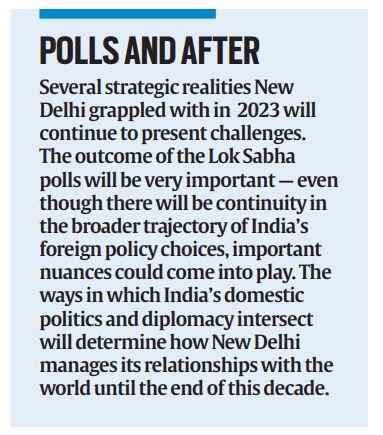 Domestic politics can play a role in India’s foreign policy decisions.
Domestic politics can play a role in India’s foreign policy decisions.
2024: Challenges, opportunities
The outcome of the Lok Sabha elections will be very important for India’s strategic and foreign policy posture.
If the NDA returns with an equivalent or stronger mandate, India’s positions on most global issues and relationships will remain consistent — and could become sharper and stronger. If the mandate is weaker, the compulsions of a coalition government could reflect in foreign policy as well.
Irrespective of the mandate, however, there will still be continuity in the broader trajectory of India’s foreign policy choices — some definite nuancing notwithstanding.
1. US & CANADA RELATIONSHIPS: A challenge lies in resolving the situation arising out of the ‘assassination plot’ in the US. Biden’s unavailability for the Republic Day celebrations may have caused some irritation in New Delhi, and the Quad summit has had to be put off for a later date, but neither India nor the US, who are deeply invested in each other, want ties adversely impacted.
The Canada allegations, meanwhile, have cast a shadow on the relationship. While New Delhi has walked back the visa curbs, Indian public opinion has been in favour of the government, and even its worst critics have not criticised the response to the Canadian allegation. Dealing with the US will not be the same as dealing with Canada, and New Delhi will not club them together.
2. NEW GOVT IN PAKISTAN: Since 2019, when the Indian government was re-elected and the constitutional changes in Jammu and Kashmir were effected, ties with Pakistan have been at a low. The change of guard in Islamabad and Rawalpindi did not make much difference, and India kept to its doctrine of indifference towards Pakistan.
Elections are now due in Pakistan, and there could be a new government there after February. Once Lok Sabha polls are over, an opportunity to restart engagement could arise. Whether that happens remains to be seen.
3. OUTCOME IN BANGLADESH: Bilateral ties have gained positive momentum in the last 15 years of the Sheikh Hasina government, and New Delhi will be keen to see her return to power in the elections due early in the new year. Security imperatives guide India’s choice in Dhaka; the Bangladesh opposition is viewed with suspicion and animosity, going by the track record of the Khaleda Zia government in the early 2000s. India will also be looking to move the efforts at improving connectivity between its Northeast and Bangladesh to a high gear, which will benefit the region and both countries.
4. CONTINUING DEADLOCK WITH CHINA: The border standoff ongoing since 2020 may feature in the election campaign, and any fresh escalation will impact both the security environment and India’s domestic political atmosphere. New Delhi will be extra careful in its response to a challenge from its biggest adversary in an election year. That imperative will frame India’s diplomacy towards China in the next few months, and even later.
5. SEEKING A WAY FORWARD IN WEST ASIA: The conflict has tested India’s position over the last two months, and has seen it evolve during this period. From early support for Israel to nuancing its position and balancing with Palestine to calling for a ceasefire in the last UN vote, India’s diplomatic positioning has followed an arc closely watched by many in the Global South. The Global South did not take India’s initial support for Israel kindly, and the defeat to Pakistan at the vote for the UNESCO vice-chair was a reality check.
The Israel-Hamas conflict could be close to running its course. The US and the rest of the West are qualifying their initial unconditional support for Benjamin Netanyahu’s actions, and moving towards greater sympathy for the people of Gaza. This is an important moment in the conflict, as more thought is given to its end, and to what comes after.
6. FUTURE OF THE WAR IN UKRAINE: The Russia-Ukraine war too has tested India’s position. Imports of Russian oil have been key to India’s efforts to keep domestic prices low, especially before elections. But pressure from the US has kept India from giving Moscow a carte blanche — this was the second year when the India-Russia annual summit at the level of leaders did not take place, and the next best opportunity will arise at the BRICS summit in Russia next year. Meanwhile, the war grinds on — perhaps inevitably towards an uneasy truce.
7. TRADE PACTS, TECH PARTNERSHIPS WITH WEST: The free trade pacts with the UK and European partners are said to be at a critical stage. Elections to the EU parliament, and possibly in the UK, are due next year — and this shrinks the policy space and flexibility for negotiators. Even so, 2024 may see these major economic diplomacy initiatives come close to fruition.
The dialogues with the US and EU on technology and trade, to remove the barriers for India to access high tech in AI, quantum computing, and cybersecurity, will be a related policy space to look out for.
Tomorrow: Technology in 2024
More Explained
EXPRESS OPINION
Apr 05: Latest News
- 01
- 02
- 03
- 04
- 05


